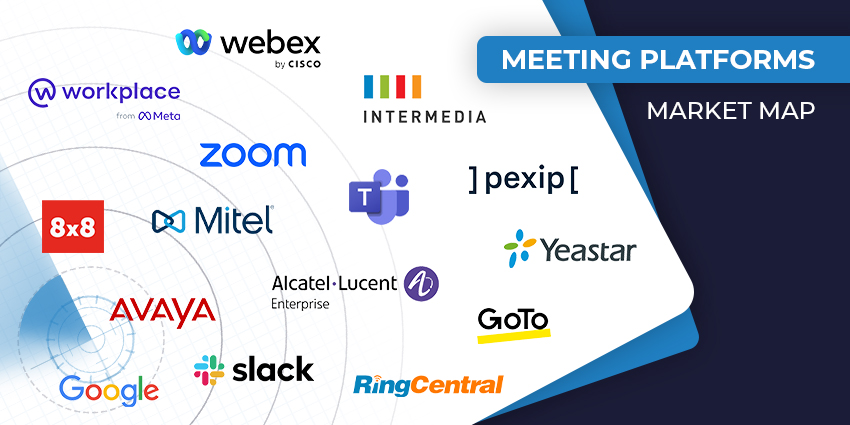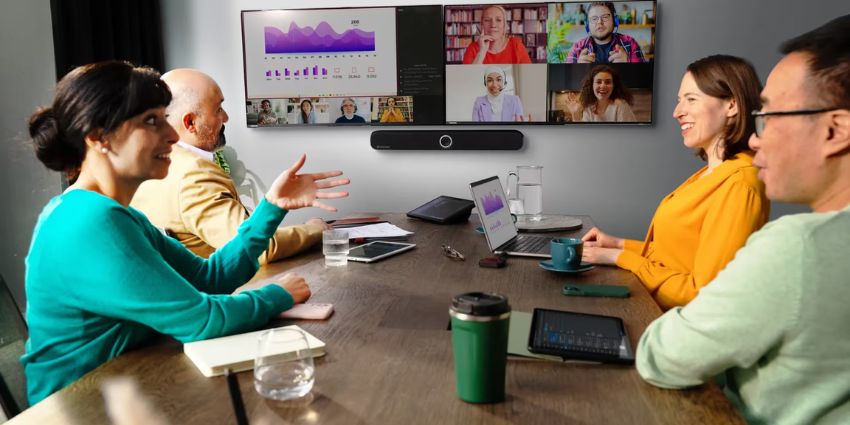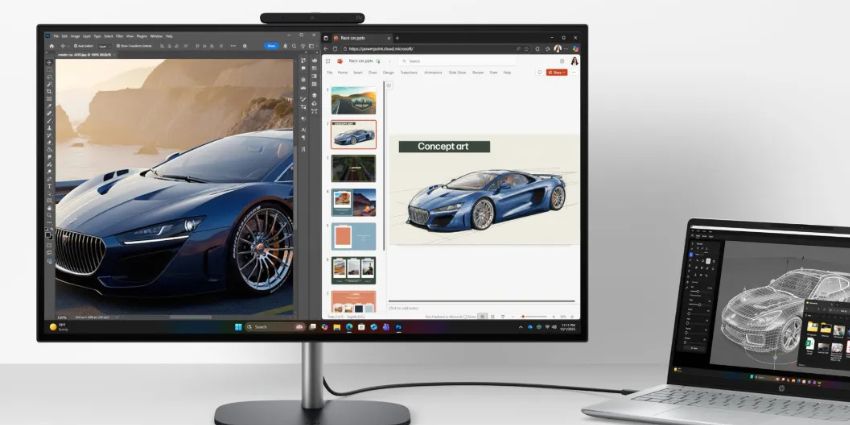Remember when a “hybrid meeting” meant a wobbly webcam, tinny audio, and half the team texting “Can you hear me?” in the chat? Those days are mostly gone, thankfully. Now, the top hybrid meeting platforms are more like control centers for how work happens.
They’re where deals close, projects take shape, and teams figure out what’s next. But the stakes have gotten higher. Now that we’re all spending more time in meetings, no-one can afford the headaches of dealing with the wrong meeting platform.
The trouble is, most vendors promise the same thing, immersive experiences, AI everything, and next-level engagement. So, how do you choose? This guide is here to help you separate the real contenders from the ones just coasting on brand recognition. We’ll walk through the best meeting platforms in 2025, so you can see exactly what works for your business.
The Top Hybrid Meeting Platforms
The Top Hybrid Meeting Platforms: Clever Collaboration
You’ve probably noticed there are a lot of options. New players pop up every year, and the old guard keeps adding shiny new tools. But the fundamentals haven’t changed much. The top hybrid meeting platforms still have to nail the basics: stable connections, decent video, strong security.
Beyond that, what sets them apart is how well they fit the real world of work as it is today. The messy reality where half the team’s remote, someone’s on a phone, and your CRM has to talk to your meeting software without throwing an error.
So let’s narrow down the big players.
Microsoft Teams
Microsoft Teams has become the default for a lot of organizations, mostly because it’s already baked into the Microsoft 365 stack. But it’s more than just a familiar logo. Over the past year, Teams has doubled down on innovation.
Copilot is playing a bigger role in meetings, drafting notes, agendas, and action items automatically. There are immersive meeting experiences available from the connected Mesh ecosystem, and all of Microsoft’s existing tools, SharePoint, Outlook, and Dynamics, align perfectly with Teams.
The basics are solid too. Video and audio are reliable. Together Mode, where everyone appears in a shared hybrid space, can help large meetings feel less stiff. Plus, Teams checks a lot of boxes for security and data protection.
Slack
Slack started out as a place for endless chat threads, but it’s steadily grown into one of the more interesting top hybrid meeting platforms. It’s now part of the Salesforce ecosystem, which means it comes with access to CRM integrations, and Agentforce features.
Slack has its own AI capabilities too, helping teams sift through channels and pull out highlights or summaries. Huddles make video conferencing seamless, with very little setup necessary, and the easy option to share content and screens during conversations.
Slack’s technology can work alongside a variety of hardware tools and endpoints and also integrates with numerous existing platforms for productivity and task management.
Zoom
Zoom has been around long enough that people use it as a verb. But it hasn’t stopped evolving. It’s still a major player for anyone in search of the top hybrid meeting platforms for video conferencing, with breakout rooms, hybrid backgrounds, and integrated messaging.
Companies can connect the system to their own phone carriers, or add-in Zoom’s own phone, workforce management, and contact center capabilities. Zoom is big on AI too, with AI-generated avatars, and AI Companion, which can generate transcripts and tasks during meetings.
Zoom also benefits from a huge range of integrations, making it easier for businesses to connect the tools they already use to collaboration workflows.
RingCentral
RingCentral has been in the game for years, mainly known for cloud phone systems. But their video meetings have matured into a capable part of the platform.
RingCentral Video is tightly integrated with their messaging and calling, so you don’t have to juggle separate apps. You can start a meeting straight from a chat thread or calendar invite. The basics are covered: HD video, screen sharing, breakout rooms, and recording.
What stands out lately is the AI-powered noise reduction, it does a surprisingly good job of filtering out background distractions without making voices sound robotic. There’s also analytics built in. IT teams can track call quality and usage trends, which helps when you’re rolling this out across hundreds or thousands of users.
Mitel
Mitel doesn’t always get the same buzz as bigger names, but it’s been steady in the enterprise communications space for decades. Its hybrid meeting features are straightforward and intuitive, built into a reliable unified communication platform.
The main power of Mitel’s meetings solution comes from its close partnership with Zoom, so businesses get all of the benefits of Zoom’s ecosystem, combined with Mitel’s heavy focus on security, resilience, and reliability.
Users can hold scheduled and ad hoc meetings with calendars, plus the technology can integrate with email, CRM, and single sign-on tools.
Cisco Webex
Cisco’s Webex solution has been one of the top hybrid meeting platforms for years. Businesses get access to everything from collaboration and communication tools to event hosting, devices, and endpoints. The Webex Teams environment offers support for video and audio conferencing, as well as the option for companies to connect their own telephony services from their preferred carrier.
There are whiteboarding tools, immersive sharing features, and recording capabilities baked in. Cisco’s environment also includes a lot of AI-powered features with Webex Assistant too. It can transcribe meetings, generate summaries, and translate conversations in real-time.
Webex integrates with Cisco’s calling and contact center tools, so it can serve as the hub for broader collaboration.
Pexip
Pexip isn’t as much of a household name, but it’s becoming one of the top hybrid meeting room platforms for businesses focused on security and compliance. Companies get comprehensive authentication and access control features, with modular, configurable technology.
You can deploy the system on-premises, in a private cloud, or through air-gapped systems. Plus, every company gets industry-leading support. Universal interoperability is another big draw, Pexip promises consistent experiences across all meeting rooms and devices, as well as support for things like Microsoft Teams, Cisco, Avaya, and Zoom.
The interface itself is clean, and the adaptive layouts do a nice job of putting the active speaker front and center without constant fiddling. You can also brand the whole experience, which helps if you want meetings to feel more like your own environment.
If you’re in Google Workspace every day, Google Meet is often the easiest path of least resistance. It’s a straightforward conferencing and meeting platform users can access for free. There are also premium features and cloud storage options available on various plans.
Over the past year, Google has kept adding little improvements. AI noise cancellation is surprisingly effective. The auto-light adjustment helps people look less like they’re calling from a basement. Live captions work well, and Companion Mode is useful for hybrid setups.
Google’s technology integrates with calendar and booking tools to assist teams with scheduling more lucrative meetings. The technology also works alongside the Gmail platform for personalised meeting reminder emails and messages.
GoTo
Offering various cloud-based tools for contact centres, connectivity, webinars, conference rooms and training, the GoTo portfolio of products is built for the new age of work. GoTo Meeting, the flagship meeting platform solution can be accessed anywhere in the world from any device.
You get HD video, cloud recording, and screen sharing that’s about as frictionless as it gets. The interface hasn’t changed much, which means there’s almost no learning curve.
Built-in enterprise-grade security in GoTo protects conversational data from being accessed by third parties. Plus, the company offers a 99.999% service uptime for business leaders. Users can access a range of in-session chat, video, and audio tools, as well as screen sharing and drawing tools and built-in VoIP accessibility.
Avaya
Avaya has been in the communications business longer than most companies have been around. They embed one of the top hybrid meeting platforms into their comprehensive solution for unified communications and collaboration: Avaya Cloud Office.
You can kick off a video call right from a chat or phone conversation. The AI assistant handles live transcription and can pick out action items to help boost efficiency after meetings. Avaya also integrates well with a range of applications. You can pull in data from CRMs or document systems without jumping between tabs.
Deployment is flexible, too. Full cloud, hybrid, or something in between, whatever fits your infrastructure. Plus, it’s easy to connect contact center features, too.
8×8
8×8 has been steadily building out its platform so companies don’t have to cobble together separate tools for calls, meetings, and messaging. Everything lives under one roof, which can be a relief if you’re tired of managing half a dozen subscriptions.
Video meetings are solid. You get HD video, screen sharing, and recording without much fuss. One standout is how global the coverage is—8×8 supports local dial-ins and compliance in more than 50 countries. For companies with offices everywhere, that matters.
Like most of the top hybrid meeting platforms, 8×8’s tools come with AI built-in. You’ll find live captions, meeting summaries, and a decent set of analytics tools to track engagement and quality.
Alcatel-Lucent Enterprise
Also known as ALE, Alcatel-Lucent Enterprise has a broad portfolio of communication products and services available. The company’s toolkit includes systems for contact centres, communication, and collaboration, CPaaS, and more.
Rainbow combines video meetings with secure messaging and file sharing. It’s designed to meet European data privacy requirements, so if you have GDPR concerns, you’ll find strong compliance controls already included.
The meeting experience is straightforward. You get video, audio, and screen sharing, plus recording and scheduling tools. AI-powered transcription is available, and the platform integrates with business apps through open APIs.
Meta
Meta’s Workplace app might be discontinued, but it still supports hybrid meetings in a new environment: the immersive world. Meta Horizon Workrooms powers extended reality meetings, and works with a wide range of devices.
It might not be the ideal choice for companies not focused on hybrid reality yet, but Meta still appeals to a wide range of forward-thinking companies. There are integrations to bring in whiteboards, shared screens, and files.
For those who need to connect with people outside of the hybrid world, Meta offers a strong integration with Zoom. Anyone can join a Zoom meeting directly from Workrooms, or add Workrooms to their Zoom call.
Intermedia
Intermedia AnyMeeting doesn’t get the same attention as Zoom or Teams, but it covers most of what small and mid-sized companies need from the top hybrid meeting platforms, without overcomplicating things.
Meetings are browser-based, so nobody has to install extra software. You get HD video, screen sharing, cloud recording, and a clean interface that’s easy to navigate. AI-powered transcription has been added recently, which helps with notes and follow-ups. Intermedia also bundles webinar capabilities, which is handy if you run a lot of customer or partner sessions.
AnyMeeting is also available as part of Intermedia Unite, the full unified communication platform with contact center, chat, business SMS, and file management.
Yeastar
The Linkus UC clients from Yeastar include the vendor’s proprietary meeting platform. The solutions are available through web browsers, mobile clients and desktop tools, with integrated tools for collaboration, such as screen-sharing and in-meeting chat.
The experience is straightforward: schedule a meeting, share a link, and start talking. You get HD video, screen sharing, and recordings without any extra plugins. Companies using the Yeastar solution for meetings can also access instant messaging and presence tools, native contact management, and integration with existing tools, such as CRM platforms.
Yeastar also offers tools for remote desk phone control, and there’s a dedicated Chrome extension available for employees who spend the majority of their time in the browser.
Upgrade Collaboration with the Top Hybrid Meeting Platforms
Choosing the right meeting platform is about reimagining how your teams connect, how fast decisions get made, and whether people actually enjoy showing up to collaborate.
The landscape is evolving fast. AI assistants are doing more of the heavy lifting. Video quality keeps getting better. New ways of working, like VR meetings, are popping up. There’s never been more choice, or more pressure to get it right.
That’s where we come in. Whether you’re exploring a full switch or just comparing a few options, UC Today is here to help you make sense of it all.
Here’s how you can keep moving forward:
- Dive deeper into the data: Download our latest research reports for insights on trends, vendor performance, and what’s coming next.
- Connect with peers: Join the UC Community to hear real-world stories from IT leaders and collaboration teams.
- See innovation firsthand: Check out upcoming events where you can test-drive platforms and meet vendors face to face.
- Master the buying process: Our Ultimate UC Buyer’s Guide walks you through every step of evaluating and selecting your next platform.
The right tools can make collaboration feel less like a chore, and more like an opportunity to fuel creativity, and growth. We’re here to help you find them.







